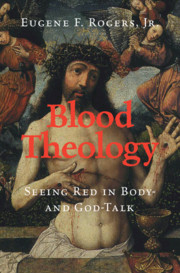Book contents
- Blood Theology
- Reviews
- Blood Theology
- Copyright page
- Dedication
- Contents
- Acknowledgments
- Part I Why We See Red
- 1 How Blood Marks the Bounds of the Christian Body
- Part II Blood Seeps in Where It Hardly Seems to Belong
- Part III Blood Makes a Language in Which to Conduct Disputes
- Part IV The Blood of God at the Heart of Things
- Appendix Review of Gil Anidjar’s Blood: A Critique of Christianity
- Sources Cited or Consulted
- Scripture Index
- Subject Index
1 - How Blood Marks the Bounds of the Christian Body
Overtures and Refrains
from Part I - Why We See Red
Published online by Cambridge University Press: 22 March 2021
- Blood Theology
- Reviews
- Blood Theology
- Copyright page
- Dedication
- Contents
- Acknowledgments
- Part I Why We See Red
- 1 How Blood Marks the Bounds of the Christian Body
- Part II Blood Seeps in Where It Hardly Seems to Belong
- Part III Blood Makes a Language in Which to Conduct Disputes
- Part IV The Blood of God at the Heart of Things
- Appendix Review of Gil Anidjar’s Blood: A Critique of Christianity
- Sources Cited or Consulted
- Scripture Index
- Subject Index
Summary
The chapter unites anthropological accounts of blood. It introduces refrains that unify themes of the entire book. It argues that blood marks the bounds of religious and social bodies, using Durkheim, Douglas, and Bildhauer; Irenaeus, Maximus, and Aquinas. Iron compounds make blood red, but societies draft its color and stickiness for their own purposes. Inside, blood carries life. Outside, blood marks the body fertile or at risk. But that’s a social fiction. Skin makes a membrane to pass when a body breathes, eats, perspires, eliminates, menstruates, ejaculates, conceives, or bleeds. Only blood evokes so swift and social a response: It brings parent to child, bystander to victim, ambulance to patient, soldier to comrade, midwife to mother, defender to border. The New Testament names the blood of Christ three times as often as his cross – five times as often as his death. The blood of Jesus is the blood of Christ; the wine of communion is the blood of Christ; the means of atonement is the blood of Christ; the kinship of believers is the blood of Christ; the cup of salvation is the blood of Christ; icons ooze with the blood of Christ; and the blood of Christ is the blood of God.
- Type
- Chapter
- Information
- Blood TheologySeeing Red in Body- and God-Talk, pp. 3 - 36Publisher: Cambridge University PressPrint publication year: 2021

